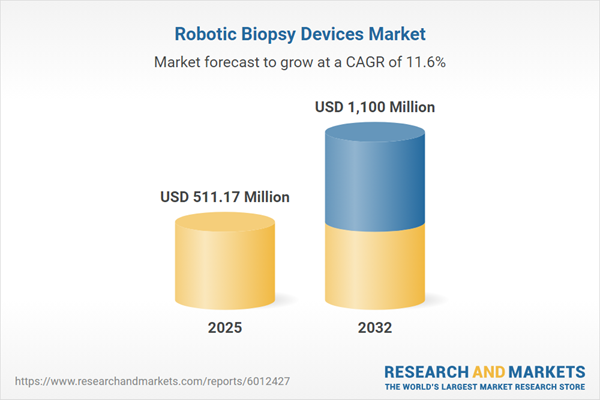Speak directly to the analyst to clarify any post sales queries you may have.
Senior healthcare leaders increasingly prioritize robotic biopsy devices to ensure diagnostic reliability, streamline operations, and advance clinical outcomes. As industry expectations for automation and care standardization accelerate, robotic solutions are emerging as an instrumental component in healthcare delivery strategies, addressing operational and clinical challenges across diverse environments.
Market Snapshot: Robotic Biopsy Devices Market
The global robotic biopsy devices market is undergoing substantial growth, driven by a continued focus on automation, precision diagnostics, and the adoption of advanced technologies in healthcare. In 2024, the market is valued at USD 458.70 million, with projections rising to USD 511.17 million for 2025 and reaching an estimated USD 1.10 billion by 2032, reflecting a compound annual growth rate (CAGR) of 11.63%.
Adoption spans hospitals, diagnostic centers, and ambulatory settings, fueling momentum. Progress in imaging platforms, the push for more standardized workflows, and strategic collaborations between providers and manufacturers influence this evolution. Key market players are, in turn, focusing on efficient resource allocation, flexible business approaches, and accessible solutions for both established and emerging healthcare markets.Scope & Segmentation
The report offers detailed segmentation to equip senior decision-makers with actionable insights for investment, strategic planning, and resource optimization in the robotic biopsy devices market. Segmentation reflects the need for adaptability, alignment with evolving healthcare models, and future-ready operational strategies.
- Product Types: Portable robotic units, robotic arms, and table-mounted systems allow integration with varying diagnostic workflows. These formats meet both inpatient and outpatient needs, contributing to flexible deployment and greater scalability for organizations.
- Technologies: Imaging-guided solutions—including CT, MRI, ultrasound, and fluoroscopy platforms—provide precise targeting and navigation for minimally invasive procedures. Their integration supports accurate and reproducible sampling across a spectrum of clinical settings.
- Applications: Systems designed for breast, lung, liver, prostate, and kidney biopsies address a variety of diagnostic cases, from routine screenings to complex, specialty-driven interventions.
- End Users: Hospitals, diagnostic centers, and ambulatory surgical centers adopt these devices to improve workflow, accessibility, and quality of care, adapting to setting-specific demands and capacity constraints.
- Procedure Types: Core needle, fine needle aspiration, and vacuum-assisted biopsies are enabled by these systems, helping clinicians fulfill accurate diagnostics for patients with diverse risk profiles.
- Regions: Patterns of adoption and technology integration vary by region, shaped by local standards and infrastructure. Significant developments are seen across the Americas, Europe, Middle East, Africa, and Asia-Pacific—each facing unique clinical and operational drivers.
- Leading Companies: Major contributors—such as Medtech SA, Medrobotics, Biobot Surgical Pte Ltd, Mazor Robotics, iSYS Medizintechnik GmbH, Renishaw plc, Medtronic, Medical Device Business Services, Inc., Stryker, and Zimmer Biomet—continually invest in product development and global supply assurance.
Key Takeaways: Strategic Insights for Senior Decision-Makers
- Automating biopsy procedures streamlines diagnostic pathways, allowing organizations to maintain consistency and efficient oversight across multiple facilities.
- Embedded imaging technology in robotic devices improves the quality and accuracy of tissue sampling, supporting data-driven, personalized care.
- Portable system formats extend advanced diagnostics to smaller facilities and resource-limited organizations, reducing barriers to care and promoting flexibility.
- Intelligent data integration and automation features facilitate coordinated workflows, improve resource utilization, and uphold robust safety protocols.
- Targeted training and education initiatives enable rapid adoption of new robotic platforms and sustained high performance as clinical models evolve.
- Regulatory updates and enhanced interoperability streamline device integration, supporting organizational readiness and technological agility in distributed care environments.
Tariff Impact
Recent US trade tariffs have introduced new considerations into the robotic biopsy devices market’s global supply chain. In response, manufacturers are shifting toward localized production, deepening supplier relationships, and refining procurement strategies. These adjustments support greater business resilience and adaptability to evolving trade regulations and market demands.
Methodology & Data Sources
Analysis in this report draws on regulatory review, current scientific literature, and patent studies, complemented by technical assessments. Market insights are validated through executive and clinical expert interviews, together with statistical evaluation of real-world device utilization and advanced analytics.
Why This Report Matters
- Supports senior healthcare and procurement leaders in benchmarking performance and shaping strategic direction as market dynamics accelerate.
- Provides actionable insights for supply chain management and operational risk mitigation in the context of shifting healthcare delivery models.
- Guides investment allocation and resource planning, ensuring readiness for emerging diagnostic and technological opportunities.
Conclusion
Robotic biopsy devices position organizations to improve diagnostic accuracy and efficiency while fostering workforce proficiency. Their integration enables healthcare leaders to navigate evolving challenges with greater assurance and operational strength.
Additional Product Information:
- Purchase of this report includes 1 year online access with quarterly updates.
- This report can be updated on request. Please contact our Customer Experience team using the Ask a Question widget on our website.
Table of Contents
3. Executive Summary
4. Market Overview
7. Cumulative Impact of Artificial Intelligence 2025
Companies Mentioned
The companies profiled in this Robotic Biopsy Devices market report include:- Medtech SA
- Medrobotics
- Biobot Surgical Pte Ltd
- Mazor Robotics
- iSYS Medizintechnik GmbH
- Renishaw plc
- Medtronic
- Medical Device Business Services, Inc.
- Stryker
- Zimmer Biomet
Table Information
| Report Attribute | Details |
|---|---|
| No. of Pages | 194 |
| Published | October 2025 |
| Forecast Period | 2025 - 2032 |
| Estimated Market Value ( USD | $ 511.17 Million |
| Forecasted Market Value ( USD | $ 1100 Million |
| Compound Annual Growth Rate | 11.6% |
| Regions Covered | Global |
| No. of Companies Mentioned | 11 |









